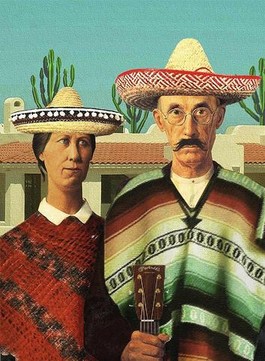Well, the numbers are in and now that we’ve had time to absorb the 2010 U.S. Census, there’s no denying some very glaringly obvious trends. White people are on the decline. Kids are on the decline. And those who are still making babies are largely—you guessed it—Latino. Let’s take a look at some outstanding trends that illustrate exactly how Latinos are taking over this country population-wise, and why that doesn’t ensure a shift in power.
The vast majority of growth in the U.S. in the past ten years is owed to non-whites.
308.7 million people resided in the United States on April 1, 2010, an increase of 27.3 million people, or 9.7 percent, between 2000 and 2010. The vast majority of the growth in the total population came from increases in those who reported their race(s) as something other than White alone and those who reported their ethnicity as Hispanic or Latino.
Latinos are having the most babies of anyone in America, with Asians close behind.
From 2000 to 2010, the population of white children nationwide declined by 4.3 million, while the population of Hispanic and Asian children grew by 5.5 million.
Whites are having the slowest growth with white births on the decline.
The amount of white babies born in the period between 2000-2010 declined in 46 states and 86 of the 100 largest metro areas. Bucking the trend is Utah where whites contributed most to child population gains, though their numbers increased only barely more than those for Hispanic children.
Whites are the minority in four states, white children are minorities in 10 states.
Hawaii, New Mexico, California and Texas (also D.C.) have minority white populations, but 10 states, including Arizona, Florida, Georgia, Maryland, New Mexico, and Nevada, (and D.C.), now have minority white child populations (Map 2). Also, in 23 states, minorities represent more than 40 percent of the child population.
Latinos and Asians are responsible for the growth in many major metropolitan areas.
Hispanics accounted for the population growth of Philadelphia, Phoenix, Indianapolis, Omaha and Atlanta. Asians did the same in Anaheim, Calif.; Fort Wayne, Ind.; Baton Rouge; and Jersey City. Without influx from the two groups, all of those cities would have shrunk.
Texas grew the most and owes it all to Hispanics.
95% of Texas’s child population growth in the past ten years occurred among Hispanics. The Dallas and Houston areas gained more children than any other metropolitan areas in the United States, with Hispanic children accounting for 931,000 of the 979,000 increases in births in Texas. This was about half of the overall national increase in children.
Los Angeles grew the least and had a Hispanic birth decline.
Bucking the trend, L.A. was the only major metropolitan area that saw a decline in Hispanic births, as well as other minority births. It also was the metro area to lose the most births overall. However, every large metro area in California has a majority minority child population in which Hispanics predominate.
Arizona adults are 62% white while Arizona kids are 42% white.
The “generation gap” in race-ethnicity that exists between children and adults in some areas portends great cultural clashes ahead. (As if we haven’t begun to see that already.) Particular metropolitan areas of Arizona with this trend include Tucson, Cape Coral, Bradenton, and Phoenix.
Minority kids are more segregated than minority adults.
Despite a general reduction in segregation over the last ten years, minorities with children tend to live in areas with less whites than those without children. This could mean that whites with children live in more exclusive neighborhoods with better schools and community services than their childless counterparts. Either way, it means minority kids are growing up with less access to the things like schools and community resources that white kids have access to, and that minority kids have less exposure to whites in general.
Hispanics Are Not In A Position To Lead
Just because minorities will comprise the majority in this country soon with Hispanics leading the way, it doesn’t mean Hispanics will be running things, or that things will get better for them politically. With a high schooldrop-out rate that is double that of African-Americans and more than four times that of whites, Latinos in this country need to get on the ball with education. History is full of examples of large populations of people of color being oppressed by a ruling class of minority whites. Heck, we only have to look at Latin America to see that.
BY GUANABEE



